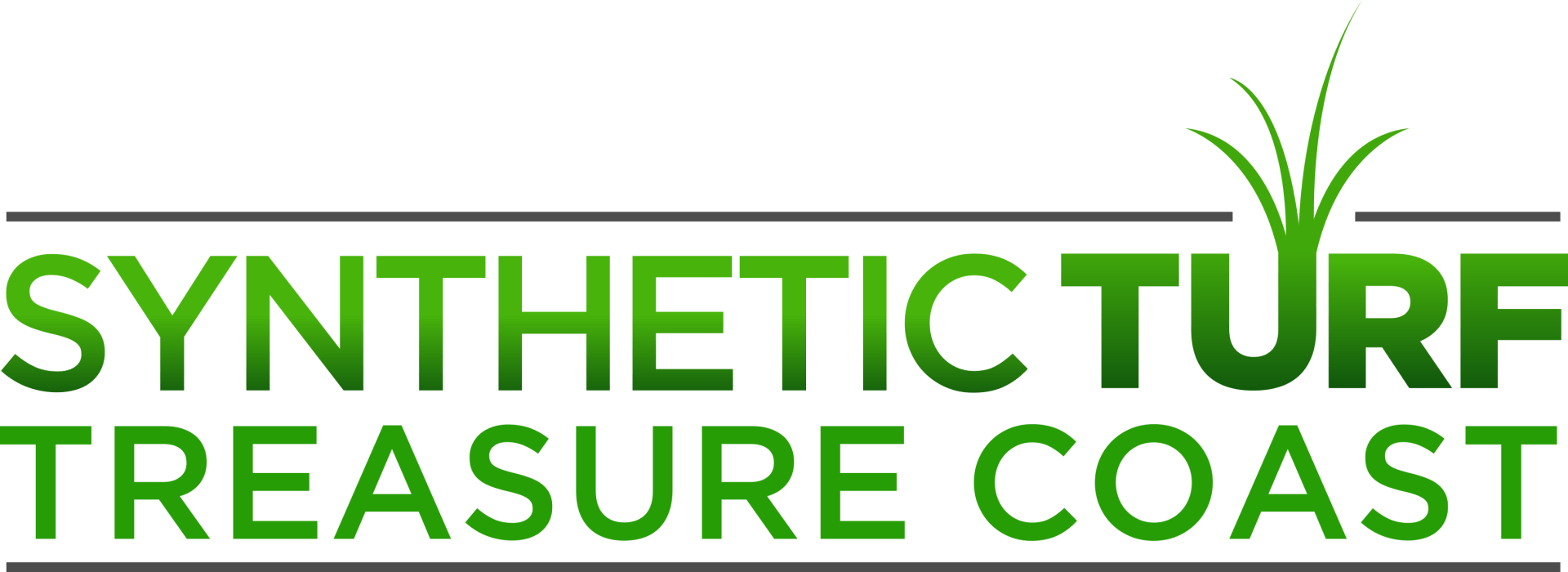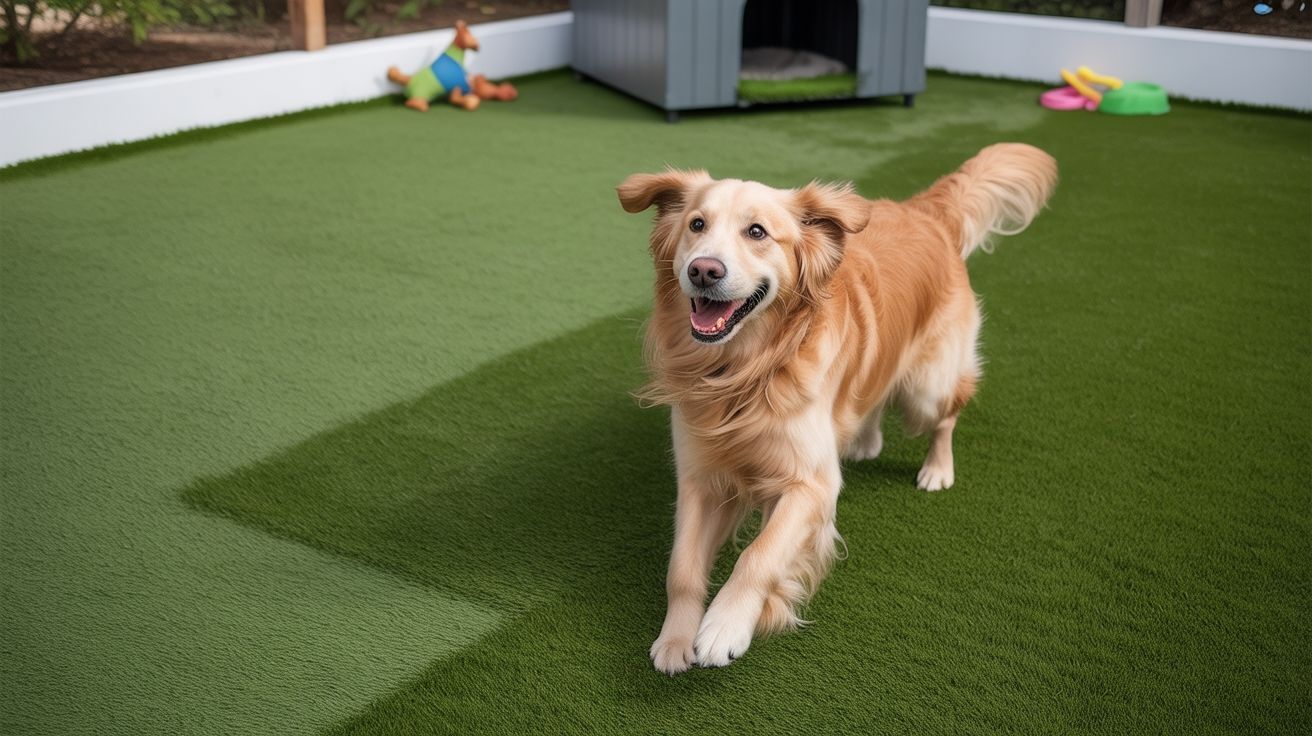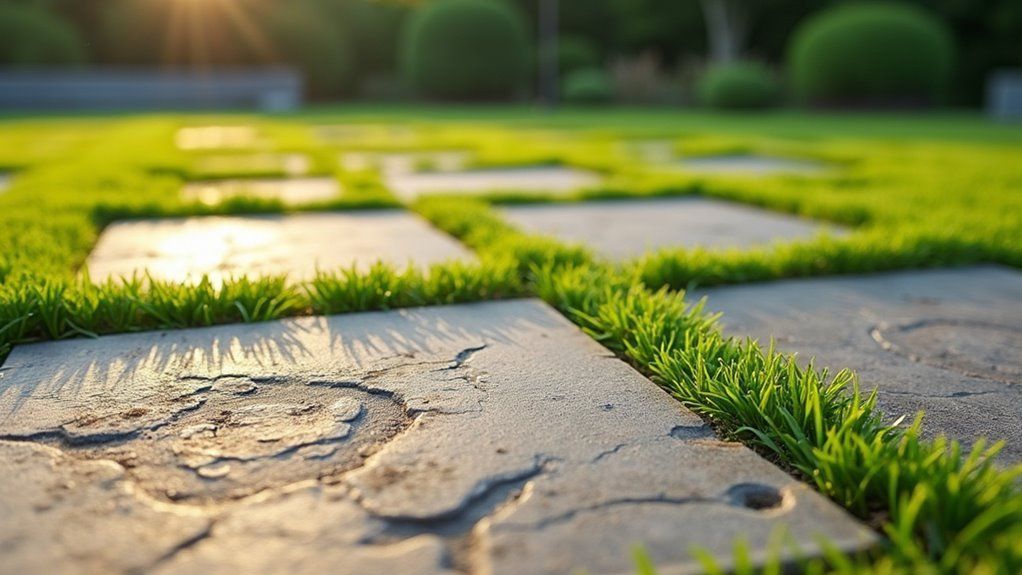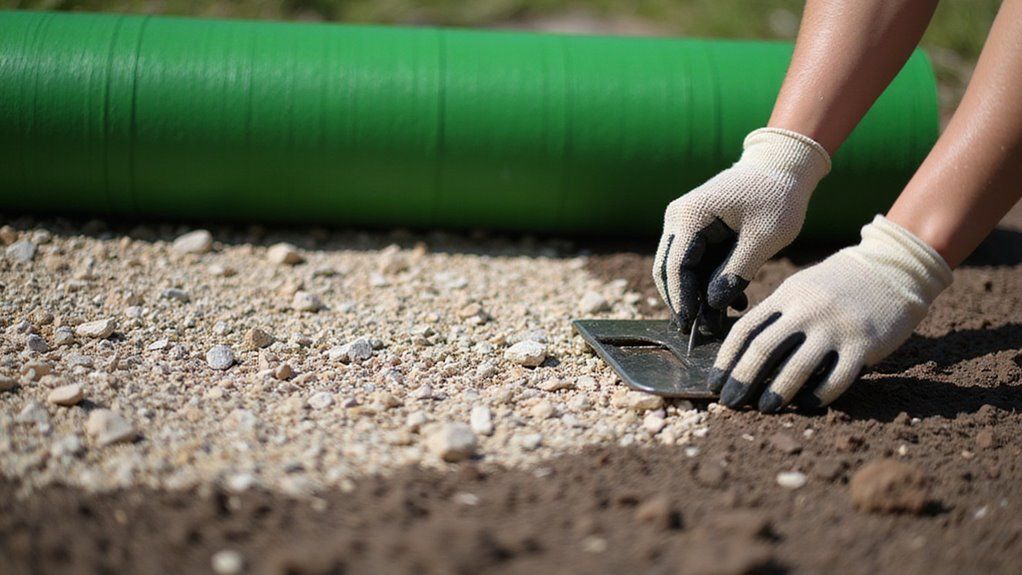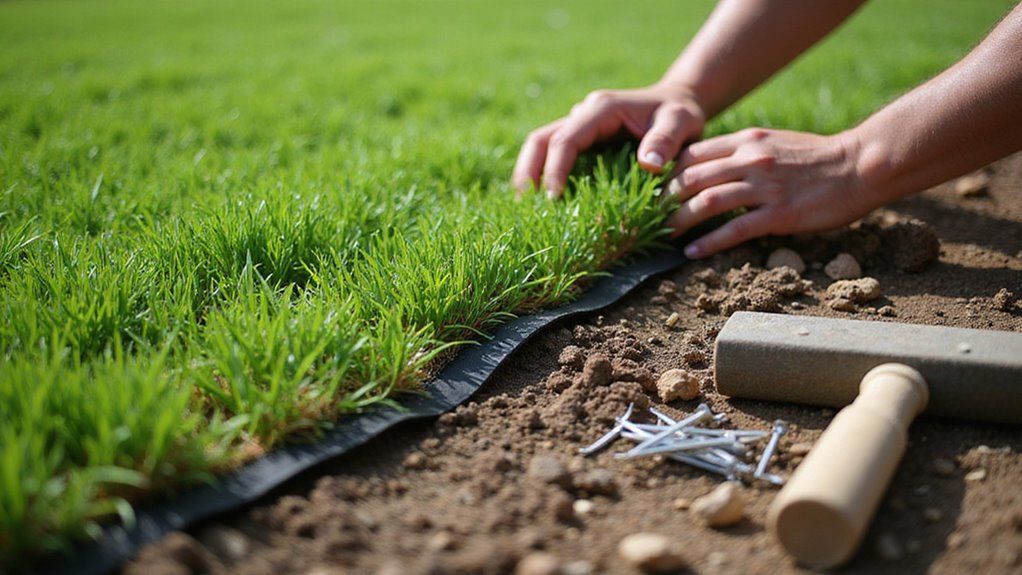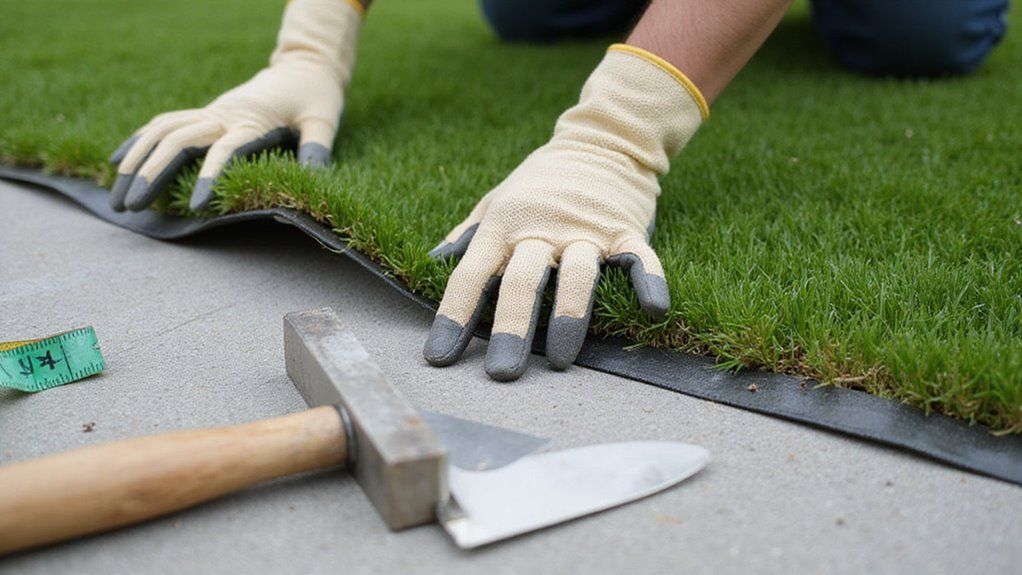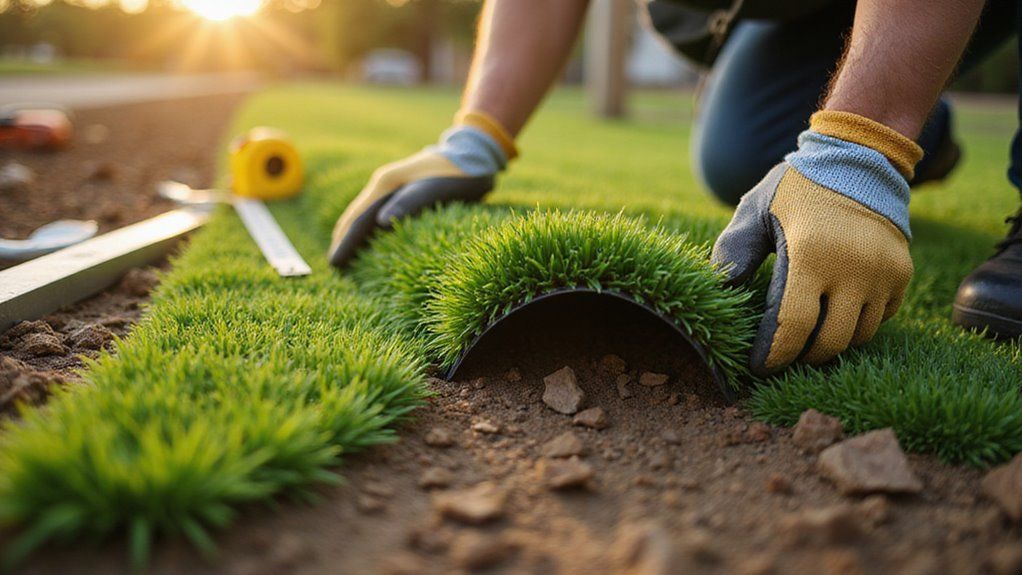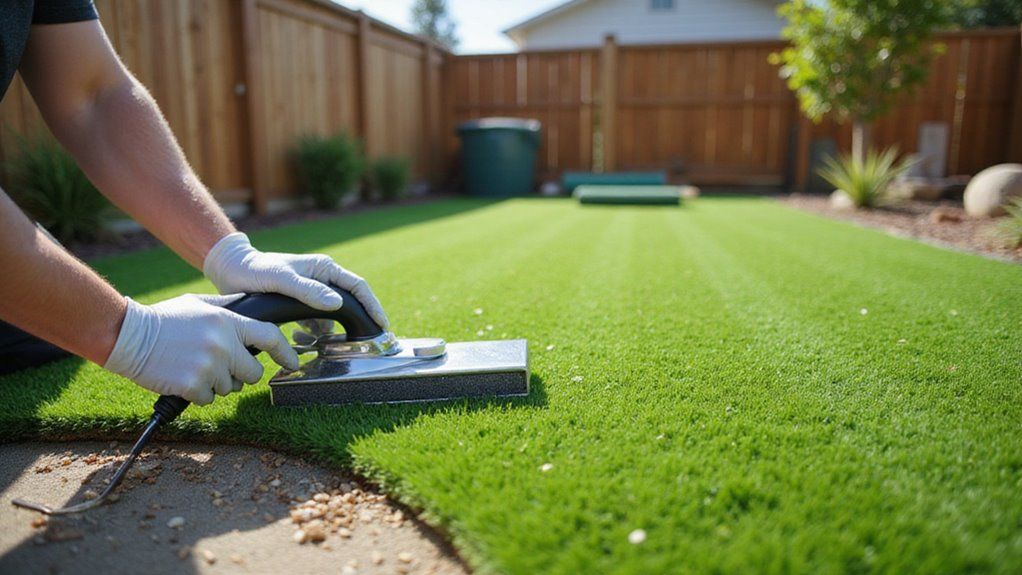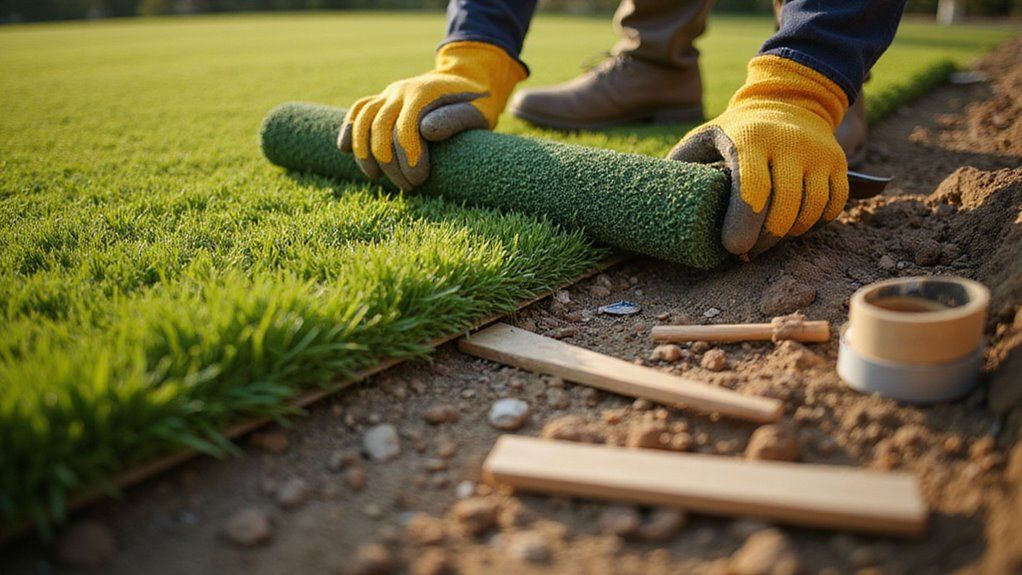How to Maintain Artificial Grass
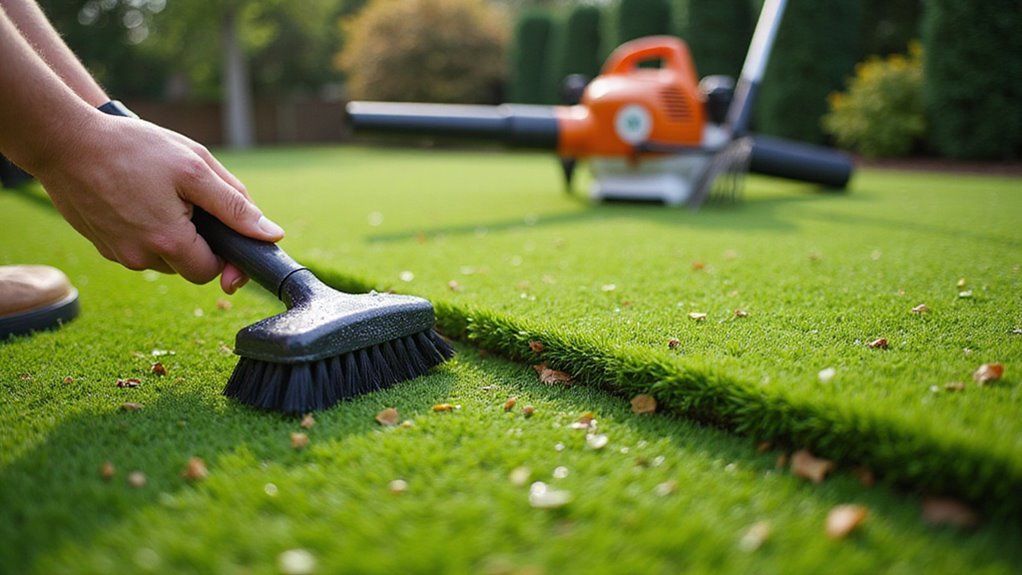
Artificial grass looks great at first, but many homeowners are shocked when their perfect turf begins to look matted and dirty. Without proper care, synthetic lawns can develop odors, lose their bounce, and become breeding grounds for bacteria. This neglect shortens the lifespan of your expensive investment and diminishes your property's curb appeal.
The problems worsen when pets use the area or when debris accumulates after storms. Stains set in, drainage issues develop, and the fibers start to flatten in high-traffic zones. Children's play areas become less safe, and the whole lawn loses its natural appearance.
Regular brushing, spot cleaning, and seasonal deep cleaning will keep your artificial grass looking fresh for years. You can maintain your synthetic turf with simple household tools and occasional professional treatments. A proper maintenance schedule prevents most common problems and extends the life of your lawn significantly.
This guide provides step-by-step instructions for caring for your artificial grass through all seasons and situations.
Key Takeaways
- Brush artificial grass weekly with stiff synthetic bristles to keep fibers upright, focusing more on high-traffic areas.
- Remove leaves, twigs, and debris promptly using a leaf blower on low power or a flexible rake with synthetic bristles.
- Clean pet waste immediately by removing solids, rinsing with water, and applying enzymatic cleaners to neutralize odors.
- Treat stains quickly by blotting spills, applying specialized cleaners, and thoroughly rinsing with cool water afterward.
- Perform seasonal deep cleaning every three months using a power broom, turf cleaner, and inspect for repairs.
Weekly Brushing Techniques to Keep Blades Upright
Artificial grass blades need weekly brushing to stay upright and look natural. You should use a brush with stiff synthetic bristles and move against the grain. Metal bristles can damage the turf, so they should be avoided.
Brush your lawn once a week for best results. High-traffic areas might need more frequent attention. Work in sections with long, firm strokes while keeping pressure even.
This method stops matting and lets air flow through the turf system. Good airflow reduces moisture and prevents bacteria from growing. If the turf is dry, brushing will be more effective.
You may need to adjust your brushing schedule during different seasons. Summer often requires more frequent brushing because of increased use. Winter typically needs less maintenance when the lawn sees less activity.
For more thorough maintenance, consider using a power broom for large areas to efficiently keep fibers upright while removing embedded debris.
Removing Leaves and Debris From Your Synthetic Turf
Artificial turf needs regular cleaning because it can't break down leaves and debris like natural grass can. Leaves and twigs must be removed before they rot and block water drainage. This maintenance keeps your turf looking good and working properly.
You can use a leaf blower on low power for large areas. Set the blower below 180 MPH and keep it at least 12 inches above the surface. If you blow too hard, you might displace the infill material that supports the turf fibers.
For stubborn debris, try a flexible rake with synthetic bristles. Work in different directions to prevent the turf from flattening in one area. This method works well for small spaces or when debris is stuck between the fibers.
Power washing once a year helps remove tiny particles that rakes and blowers miss. Use medium pressure under 1500 PSI and clean one section at a time. If sections remain wet too long, mold might grow underneath your turf.
Clear all grass of rubbish especially after strong winds or storms when debris accumulation is highest.
Effective Methods for Rinsing Away Dust and Pollen
Regular rinsing removes dust and pollen from artificial turf. These particles can discolor your lawn and block drainage. A good cleaning routine keeps your synthetic grass looking fresh and working well.
Use a garden hose with medium pressure for best results. Too much pressure might wash away the infill material. The water should be strong enough to remove debris but gentle enough to protect your turf.
Timing matters when rinsing your artificial lawn. Rinse every two weeks during high pollen seasons. Monthly rinsing works fine during low-allergen periods.
You can use a mild soap solution for stubborn dirt. Mix one part detergent with twenty parts water quarterly. This breaks down tough airborne residues that won't rinse away with water alone.
Water should flow from high to low areas of your lawn. This helps with drainage and stops water from collecting in puddles. If water pools, it might cause mildew problems later.
Morning is the best time to rinse your turf. Cooler temperatures allow the surface to dry completely afterward. If the turf stays wet too long, mildew might grow.
Weekly light spraying helps maintain your artificial grass's stain-resistant properties while eliminating the need for frequent mowing that natural lawns require.
Pet Waste Management on Artificial Grass
Managing pet waste on your artificial turf requires a systematic approach for maintaining sanitary conditions. You'll need to immediately remove solid waste using a pooper scooper or plastic bag, then thoroughly rinse the affected area with a hose to flush away residual matter and prevent ammonia buildup.
Schedule regular deep cleaning treatments with enzymatic cleaners specifically formulated for synthetic surfaces to neutralize odors and eliminate bacteria that conventional rinsing can't address. The anti-microbial coating featured in quality artificial turf helps prevent bacteria growth and odors between cleanings.
Remove Waste Promptly
Pet waste must be removed quickly from artificial turf. Quick cleanup prevents bad smells and stops harmful bacteria from growing. It also keeps waste from getting stuck in the turf fibers.
You should use special pet waste bags for cleanup. Rinse the area with water after removing solid waste. This helps wash away any leftover material.
Apply enzyme cleaners made for synthetic turf to remove odors. Do deep cleaning with antimicrobial products regularly. These products kill bacteria that cause persistent smells.
If you wait too long to clean up waste, odors will stay in your turf. Most turf warranties require proper waste management. Your investment stays protected when you follow these practices.
Rinse Thoroughly After
Always rinse your artificial grass after removing solid waste. Use plenty of water to wet all the turf fibers completely. This washing removes tiny waste bits and gets rid of bad smells.
You can mix a turf cleaner with water using a 4:1 ratio for better results. Apply this mixture with a spray pump from the edges toward the middle. Keep rinsing until the water runs clear and no smell remains.
Drying the turf properly is important too. You might use a microfiber cloth to dry busy areas faster. If you prefer, let air dry the turf naturally to stop bacteria from growing.
Deep Clean Regularly
Pet owners should deep clean their artificial turf every 4-6 weeks. The cleaning schedule depends on how many pets use the area. Deep cleaning stops ammonia buildup and kills bacteria that simple rinsing misses.
You can get great results with these cleaning methods. Apply enzyme cleaners made for fake grass to break down pet waste. Use a power brush with your hose or a special rake to lift flattened fibers.
A water and white vinegar mix (3:1) works well for sanitizing. Spray it evenly with a pump sprayer. If you have a large area, you might want to rent a turf vacuum.
This cleaning routine helps your turf last longer. It also keeps the area clean for pets and family. Your outdoor space will stay fresh and safe with regular maintenance.
Addressing Stubborn Stains and Spills
Addressing organic spills on artificial turf requires immediate action with a microfiber cloth to blot—not rub—the affected area before applying a specialized turf cleaner.
For persistent pet stains, apply an enzymatic cleaner specifically formulated for synthetic grass to break down organic compounds without damaging the fibers or backing.
You'll need to rinse thoroughly with cool water after treatment to flush residual cleaning agents and prevent discoloration or tackiness that could attract more dirt. For stubborn red wine stains, you may need to scrub with a hot water and soap mixture and repeat until the stain is completely lifted.
Organic Spill Solutions
Organic spills need quick action to prevent stains on artificial turf. Pet waste, food, blood, or plant matter can ruin the look of your synthetic lawn. Simple home mixtures can clean these messes without harming the turf material.
White vinegar and water in equal parts works well on protein stains. This mix breaks down tough spots and removes bad smells. You can apply it directly to the affected area.
Baking soda helps with wet spills by soaking up the liquid. Wait until it dries completely before vacuuming it away. This method works best for fresh spills.
Mild dish soap mixed with warm water cleans most organic debris. Use one tablespoon of soap per gallon of water. The solution lifts dirt without leaving harmful residue.
If you find tree sap or sticky substances, try using mineral spirits. Apply a small amount with a clean cloth. You should rub gently to avoid damaging the fibers.
Always rinse the area after cleaning to remove any leftover product. Residue can attract more dirt if left behind. Your turf will stay cleaner longer with proper rinsing.
Pet Stain Removal
Clean pet messes from artificial turf right away to avoid damage. Remove solid waste first, then rinse the area with cool water. This helps dilute any urine that may have soaked into the turf.
Use an enzyme cleaner made for fake grass to tackle odors. These cleaners break down urine instead of just covering up smells. Let the cleaner soak for 10 minutes before rinsing it off.
You should regularly clean areas where pets go often. Mix equal parts vinegar and water for routine cleaning. Hydrogen peroxide works well on tough stains if needed.
Never use ammonia products on pet stains. They can make pet odors worse and attract animals back to the same spot.
After cleaning, brush the turf fibers upright to restore their appearance. If allowed, sprinkle deodorizing turf sand on the area. This helps absorb future accidents and keeps proper drainage.
Seasonal Deep Cleaning Procedures
Deep cleaning of artificial turf should happen every three months. This keeps your turf working well and helps it last longer. You might need to clean more or less often depending on use, weather, and maker's advice.
Deep cleaning works best with special tools that remove hidden dirt. A power broom should be used against the grain to lift flat fibers. This brings hidden dirt to the surface.
Apply a turf cleaner that breaks down organic matter safely. Clean in different directions to get all the dirt out. Add silica sand afterward to keep fibers standing up and help water drain.
Let your turf dry for 1-2 days before using it again. This prevents damage and ensures the cleaning was effective.
Always inspect your lawn for loose seams or tears during your seasonal cleaning to catch potential issues before they worsen.
Preventing Weed Growth Around Edges
Preventing persistent weed growth around your artificial turf requires implementing three critical barrier methods. You'll need to install proper perimeter barriers that create physical separation between your turf and surrounding soil, while augmenting this with professional-grade weed barrier fabric beneath the installation.
Edge sealing techniques using specialized adhesives or mechanical fastening systems will complete your defense strategy, effectively preventing unwanted vegetation from compromising your synthetic lawn's appearance and structural integrity.
Regular debris removal helps prevent decomposition of organic materials that could otherwise promote weed growth around the edges of your artificial grass.
Secure Perimeter Barriers
Three main barriers protect your artificial turf edges from weeds. Border protection creates a clean boundary between your turf and surrounding areas. These barriers keep your lawn looking neat and weed-free.
A concrete mow strip makes a clear division between turf and natural landscaping. Commercial weed membrane should extend 4-6 inches past your turf boundaries. These physical blocks prevent unwanted plant growth.
Retaining walls help on sloped areas by stopping soil erosion. They also block weeds from migrating into your turf. If you have uneven ground, this option works best.
Metal or polymer edging creates a strong root barrier when buried 2-3 inches deep. These edges block underground root spread from nearby plants. Your turf will last longer if weeds can't invade from below.
Proper barrier installation reduces the time you'll spend on maintenance. Your synthetic turf will maintain its appearance for many years. If barriers are correctly placed, edge deterioration becomes much less likely.
Weed Barrier Installation
A good weed barrier stops unwanted plants from growing under your artificial turf. Choose a strong fabric that blocks light but lets water pass through. The barrier should extend beyond your turf edges by 6-8 inches.
Secure the edges with metal pins placed every 4-6 inches around the border. Fold corners twice to keep them from lifting up. You can also apply weed-killing chemicals under the barrier for extra protection.
When using multiple fabric sheets, overlap them by at least 6 inches. Fasten these overlaps with landscape staples. Make sure there are no gaps in your barrier, especially where your artificial turf meets natural ground.
Edge Sealing Techniques
Edge sealing stops weeds from getting into your artificial turf. It prevents shrinkage and creates a barrier that keeps your lawn looking clean. You can choose from several proven methods for this important step.
Metal edging works well when secured with galvanized stakes. The edges must be trimmed carefully for a flush fit. This option provides good stability in most soil conditions.
Composite lumber makes strong barriers when installed below grade level. It won't expand much when wet. If you live in a rainy area, this might be your best choice.
Concrete curbing creates a solid boundary all around your lawn. It blocks roots completely. Concrete will last for many years without needing replacement.
Polyurethane sealant can be applied directly to turf edges. It forms a flexible seal that moves with the ground. The sealant works especially well in areas with freezing and thawing cycles.
You should check your sealed edges regularly for any damage. Early detection prevents weed problems before they start. Your turf will stay beautiful longer if you maintain these boundaries.
Snow and Ice Removal in Winter Months
Winter brings challenges for artificial grass that need careful handling. You should never use metal shovels or sharp tools on your turf. Plastic snow shovels with rounded edges work best when used parallel to seams.
Rock salt and calcium chloride can harm your turf fibers. Special snow melt products made for synthetic turf are safer options. These products can dissolve ice without damaging your installation.
Let snow melt naturally when you can. Too much manual removal might flatten the grass fibers. After the snow melts, brush the turf gently to restore its direction and remove any leftover debris. Regular brushing helps prevent matting and maintains a natural appearance after winter weather conditions subside.
Eliminating Odors From Your Artificial Lawn
Proper pet waste management forms the foundation of odor control, requiring immediate removal of solid waste and thorough rinsing of affected areas with water.
You'll need to apply specialized enzymatic cleaners specifically formulated for artificial turf to break down remaining organic compounds that cause persistent odors. For stubborn or widespread odor issues, consider professional-grade deodorizing treatments containing antimicrobial agents that penetrate the turf backing to eliminate bacteria colonies and restore your lawn's fresh appearance.
Scheduling regular debris collection using a leaf blower or broom will also help prevent odor-causing materials from decomposing into your artificial grass surface.
Pet Waste Management
Artificial grass needs regular cleaning when pets use it as a bathroom. Pet waste won't break down naturally on fake grass like it does on real grass. You must clean it properly to avoid bad smells.
Pick up solid waste right away with a bag or scooper. Put the waste in a trash can with a lid. This prevents bacteria from spreading on your turf.
Wash the dirty area with cool water after removing waste. The water helps flush away tiny particles into the drainage system. Special pet-safe cleaners can break down any leftover waste.
You could create a special spot just for your pet's bathroom needs. This makes cleaning easier because waste is in one area. If many pets use your lawn, you might need extra drainage systems.
Regular cleaning keeps your artificial grass looking and smelling fresh. Check pet areas more often during hot weather. Your synthetic lawn will last longer with proper waste management.
Deodorizing Treatment Options
Artificial turf may develop odors over time despite regular cleaning. Pet areas often get smelly faster than other spots. You can use special sprays made for fake grass to remove these bad smells.
These products contain enzymes that break down the bacteria causing odors. They work better than products that just cover up smells. Spray these deodorizers after washing and rinsing the smelly areas.
Let the area dry completely before walking on it again. Apply these products once a month in busy areas. You should also use them right after cleaning up large amounts of pet waste.
Professional cleaning services can help with very bad smells. They have special equipment to clean deep into the turf backing. Their industrial treatments can prevent new odors while keeping your turf looking nice.
Maintaining Proper Infill Levels
Your artificial grass needs the right amount of infill to last longer and perform well. Check infill levels every three months in areas that get heavy use. Add more infill when you see uneven areas or exposed fiber bases.
A depth gauge helps you measure current infill against what the manufacturer recommends. Always add new infill in thin layers instead of one thick layer. Brush the material across the direction of the turf fibers for better distribution.
Water the area lightly after adding infill. This helps the materials settle evenly throughout the surface. Professional help is best for larger areas.
If you replace infill, use the same type as your original material. Options include silica sand, crumb rubber, or acrylic-coated infill. Matching materials ensures your turf maintains consistent performance.
Use a hard-bristle push broom in the direction of the blades when distributing infill to ensure uniform coverage throughout your artificial turf.
Repairing Minor Damage and Seams
Small tears and lifted seams need quick attention. Fixing minor damage prevents bigger problems. This simple maintenance saves you money in the long run.
Apply turf adhesive under tears smaller than 6 inches. Press firmly until the adhesive bonds the material. Larger damage needs a replacement patch and proper seaming tape.
Always use products made for outdoor synthetic turf. UV-resistant tape and outdoor adhesive work best. These materials stand up to weather and sun exposure.
Check your turf seams every three months. Clean any lifting areas before adding new adhesive. If seams continue to cause problems, a professional can use heat-bonding methods.
Professional repairs are nearly invisible. They maintain your turf's structure and appearance. Experts have special tools that create stronger bonds than DIY methods.
Avoiding Common Maintenance Mistakes
Homeowners often damage synthetic turf through simple maintenance errors. These mistakes reduce your lawn's lifespan and ruin its appearance. Proper care helps avoid costly repairs later.
Never use petroleum-based products on artificial grass. These chemicals break down the synthetic fibers and backing materials. Your lawn will deteriorate quickly if exposed to these substances.
Keep hot items away from your turf surface. Grills and fire pits cause permanent melting damage. The synthetic material cannot be repaired once melted.
Don't overwater after cleaning your artificial lawn. Excess water promotes mold growth in the infill and subbase. If you notice musty smells, your turf might have trapped moisture.
Always dry your turf properly after deep cleaning. Poor drying leads to matting and fiber damage. Your lawn will look flat and worn if not dried correctly.
Clean spills by removing solid debris first. Then rinse the area with minimal water. If stains persist, only use cleaners approved by the manufacturer.
Inspect your lawn regularly for maintenance issues. Early detection prevents small problems from becoming major concerns. Your artificial turf will last longer with consistent attention.
Essential Tools for Artificial Grass Upkeep
A stiff-bristled broom or rake keeps artificial turf looking fresh. Leaf blowers remove debris without disturbing the infill material. Garden hoses with adjustable nozzles help clean spills and pet waste areas effectively.
Power brushes reach deep into synthetic fibers for thorough cleaning. You should store all maintenance tools away from harsh weather. Tools last longer when properly protected in a dedicated storage space.
Maintenance needs change with the seasons. Fall requires more frequent grooming because of falling leaves. Spring cleaning addresses pollen buildup that can affect the turf's appearance.
If you use the right tools, your artificial grass will stay beautiful year-round. Regular maintenance prevents matting and keeps fibers standing upright. The small effort of proper upkeep saves money on repairs or early replacement.
Long-Term Care Strategies to Extend Lifespan
People can live longer with proper care strategies. Good planning and healthy habits make a big difference. Regular check-ups help catch problems early.
Good drainage systems prevent health issues. Many seniors benefit from proper hydration and nutrition. They should drink enough water daily.
Annual health assessments maintain body function. These check-ups can reveal hidden problems before they worsen. Early detection saves lives.
Non-toxic environments promote better health outcomes. Harmful chemicals in homes can damage lungs and other organs. Air purifiers might reduce these risks.
Professional medical consultations should happen every 2-3 years minimum. Doctors can spot changes that patients might miss. If symptoms appear, you should seek help immediately.
Quarterly self-examinations help monitor health changes. Address any concerning issues right away. Small problems could become serious if ignored.
Conclusion
Proper maintenance is the key to extending your artificial grass's life. Simple tasks like regular brushing help restore flattened blades to their upright position. Removing debris and organic matter prevents unwanted growth and keeps your lawn looking fresh.
If your turf gets heavy use, you might need to brush it more frequently. Seasonal deep cleaning will remove embedded dirt and rejuvenate your lawn's appearance. With minimal care, your synthetic turf will maintain its beauty for many years.
Your artificial grass is an investment that pays dividends through reduced water usage and maintenance time. Following these simple guidelines will protect that investment for years to come. Install Your Artificial Grass with Synthetic Turf Treasure Coast for professional results that last.
About the author
Kathy Leavell
Kathy Leavell is the founder and owner of Synthetic Turf Treasure Coast, a leading provider of synthetic grass solutions for residential and commercial properties in Florida. With over a decade of experience in the industry, Kathy has become a recognized expert in synthetic turf installation, maintenance, and repair. Under her leadership, Synthetic Turf Treasure Coast has earned a reputation for exceptional customer service and high-quality workmanship.
Prior to starting her own business, Kathy worked in sales and marketing roles at several major synthetic turf manufacturers.
